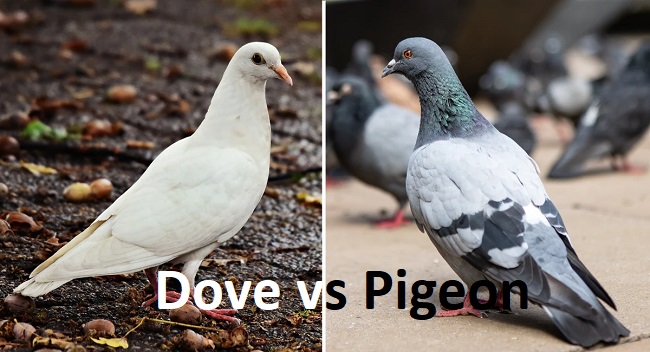Doves and pigeons: two birds often considered synonymous. Are they the same or different species?
In this comprehensive guide, we explore the surprising distinctions and similarities, from their physical characteristics to their behaviors, habitats, and cultural significance.
Let’s embark on this fascinating journey into the world of Doves vs Pigeons.

The Common Misconception: Are Doves and Pigeons the Same?
The first key point to understand is that ‘dove’ and ‘pigeon’ are both terms used to describe bird species within the Columbidae family. This family contains over 300 species, some of which are referred to as doves, and others as pigeons.
Read Also:
So, are they different? Well, yes and no. They belong to the same family, but the terms ‘dove’ and ‘pigeon’ are used interchangeably, often depending on regional dialect or tradition.
Physical Differences
While there is substantial overlap, some general differences in appearance between doves and pigeons do exist. Doves tend to be smaller and sleeker with pointed tails, while pigeons are larger, stouter, and have broader, rounded tails.
Behavioral Variations
The behavioral characteristics of doves and pigeons largely depend on the specific species rather than whether they’re classified as a dove or pigeon. Some species are solitary, while others form large flocks.
Both doves and pigeons are known for their exceptional navigational abilities, making them valuable for carrying messages over long distances.
Differentiating by Habitat
Both pigeons and doves are found worldwide, inhabiting every continent except Antarctica. Their habitats range from forests to deserts to urban areas.
However, species referred to as pigeons are often those seen in urban or suburban environments, while those called doves tend to be associated more with rural or wilderness areas.
Symbolism and Cultural Significance
Both doves and pigeons hold a wealth of symbolism in various cultures. Doves are often seen as symbols of peace, love, and tranquility. Pigeons, despite being essentially the same family of birds, often don’t share this same positive symbolism, frequently viewed as pests in urban areas.
The Dove and Pigeon Spectrum
The diverse array of species within the Columbidae family showcases a multitude of physical characteristics, sizes, and color patterns.
From the small and delicate Diamond Dove to the substantial and robust Rock Pigeon, this wide spectrum encompasses an impressive array of avian diversity.
The Bird of Love and Peace: Doves in Human Culture
Doves are deeply entrenched in human culture and symbolism. Their white color and graceful flight have led them to become universal symbols of love, peace, and purity.
Doves are frequently used in various religious and cultural practices and have made their way into literature, art, and even popular culture.
Pigeons: Much More Than Just City Dwellers
While pigeons are commonly associated with urban environments, not all pigeon species are city dwellers.
For instance, the Band-tailed Pigeon is native to the forests of the western United States, while the Spinifex Pigeon calls the arid landscapes of Australia home.
This goes to show that pigeon species are adaptable and have managed to make a home in a wide range of habitats.
The Dove-Pigeon Connection: How Language Shapes Perception
Language plays a significant role in shaping our perception of doves and pigeons. Due to cultural or regional preferences, doves are often perceived more positively, while pigeons tend to be seen in a more negative light.
This difference in perception is an excellent example of how language and culture can influence our understanding and appreciation of nature.
Homing Pigeons: The Bird Messengers
One of the fascinating aspects of pigeons, specifically homing pigeons, is their use in delivering messages over long distances.
Known for their exceptional navigational abilities, these birds have been used throughout history, including in both World Wars, to carry critical messages.
Conservation Status: Threats to Doves and Pigeons
Many dove and pigeon species face threats due to habitat loss, hunting, and predation. Some species, like the Socorro Dove and the Passenger Pigeon, have experienced dramatic declines or even extinction. Conservation efforts are critical to ensure the survival of these diverse and remarkable birds.
Read Also:
Conclusion
In the Dove vs Pigeon debate, the differences and similarities can be quite surprising. Despite the common misconception, these terms don’t distinctly categorize separate species but are used interchangeably based on cultural or regional preferences.
Whether it’s a pigeon cooing in your city square or a dove rustling in your garden, these birds offer a fascinating study in the way we perceive and categorize the natural world.
























